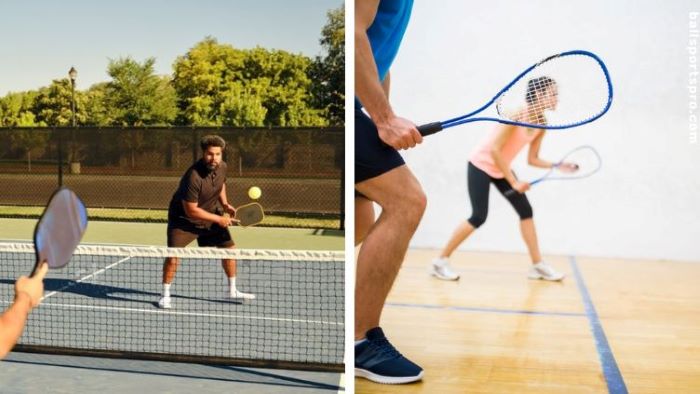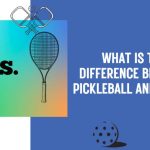You might have heard of squash and pickleball if you love racquet sports. But do you know what makes them different and how to switch from one to the other?
Squash and pickleball are exciting and fun games that can keep you fit and entertained. But they also have many differences that can affect your performance and enjoyment. This article compares and contrasts squash and pickleball in four key areas: equipment, court, rules, and scoring. We will also give you some handy tips on transitioning from squash to pickleball.

Whether you are an experienced squash player looking for a new challenge or a newbie who wants to try out both games, this article will help you discover the differences between squash and pickleball (Squash vs. Pickleball).
What’s the Difference Between Squash and Pickleball?
Squash and pickleball are two different sports played with a racquet and a ball, but they have many differences in equipment, court, rules, and scoring. Let’s explore some of the differences –
Pickleball Paddle vs. Squash Racquets
- Squash racquets are longer and thinner, with a smaller surface area for making contact with the ball. They have strings like tennis racquets.
- Pickleball paddles are shorter and wider, with a larger surface area for hitting the ball. They are solid and have no strings. They are usually made of carbon fiber, graphite, or composite materials.

Pickleball Balls vs. Squash Balls
- Pickleball balls are smooth, durable plastic with between 26 and 40 regular-sized holes. In diameter, they measure between 2.874 and 2.972 inches.
- Squash balls are rubber, bouncier, harder, and smaller than pickleball balls. They have different colors to indicate their bounce level, depending on the level of play. The more elite a ball is, the smaller and less bouncy it becomes.
Squash Courts vs. Pickleball Courts
- Pickleball courts are 20 feet by 44 feet, with a net in the middle that is 34 inches high at the center. The court is divided into two service zones on each side, and there is a non-volley zone (also called the kitchen) that extends 7 feet from the net on both sides. Pickleball courts can be indoor or outdoor.
- Squash courts are 21 feet by 32 feet, with four walls surrounding the whole court. The walls have lines that mark the out-of-bounds area and the service area. Tin at the bottom of the front wall also acts as a lower boundary for shots. Squash courts are indoor only.

Pickleball Rules vs. Squash Rules
- Pickleball rules state that the ball can only bounce once before the player must return it, and it must land inside the court boundaries or on the lines. The serve must be underhand and diagonal and clear the non-volley zone. The first two serves of each side are faulted if they land in the non-volley zone. Only the serving team can score points by winning rallies.
- Squash rules state that the ball can only bounce once on the floor before the player must return it, but it can bounce off the walls multiple times as long as it stays within the boundaries. The serve must be overhand and hit above the service line on the front wall, and it must land in the opposite quarter court. Either team can score points by winning rallies or forcing errors from their opponents.
How to Transition From Squash to Pickleball?
Squash and pickleball are both racquet sports that require agility, strength, and strategy, but they have many differences that can make the transition challenging for squash players. Here are some tips on how to adapt to pickleball from squash:
Tip 1: Adjust Your Equipment
- Pickleball paddles are shorter, wider, and more solid than squash racquets, which are longer, thinner, and strung. You may need to experiment with different paddle materials, shapes, and weights to find the one that suits your style and preference.

- Pickleball balls are larger, softer, and have holes than squash balls, which are smaller, harder, and solid. Pickleball balls have less bounce and spin than squash balls, so you must adjust your timing, angle, and force when hitting them.
- Pickleball courts are smaller and have a net in the middle than squash courts, which are larger and have four walls. Pickleball courts also have a non-volley zone (also called the kitchen) that extends 7 feet from the net on both sides, where you cannot hit the ball in the air.
Tip 2: Change Your Tactics
The most basic tactic in pickleball is to get to the net as quickly as possible. You want to move up to the “kitchen” or Non-Volley Zone line, where you can dominate the rallies with volleys and putaway. In squash, you want to stay in the center of the court, where you can cover all angles and shots.
The most common shot in pickleball is the drop shot, a soft shot that lands in the opponent’s kitchen, forcing them to hit up. The drop shot is used to transition from the baseline to the net or to keep your opponent back. In squash, the most common shot is the lob, a high shot that bounces off the back wall, forcing your opponent to move back.
The serve in pickleball is underhand and diagonal, and it must clear the non-volley zone. The serve is not a weapon in pickleball but rather a way to start the rally. You want to serve deep and low, or with some spin or placement, to make it harder for your opponent to return.
The serve in squash is overhand and straight or cross-court, and it must hit above the service line on the front wall. The serve is a weapon in squash, and you want to serve hard and tight or with some deception or variation to pressure your opponent.
Tip 3: Learn the Rules
The scoring system in pickleball is different from squash. In pickleball, you play until one team reaches 11 points and wins by two clear points. Only the serving team can score points by winning rallies.

The first two serves of each side are faulted if they land in the non-volley zone. In squash, you play until one player reaches 11 points and wins by two clear points. Either player can score points by winning rallies or forcing errors from their opponents.
Pickleball rules also have some unique features you need to be aware of. For example, you cannot volley (hit the ball in the air) within the non-volley zone or while stepping into it. You cannot hit the ball before it bounces once on your side of the court (except on the serve return).
You must also let the ball bounce twice before hitting it back if it hits the net during a rally. In squash, you can volley anywhere on the court if you hit the ball before it bounces twice on the floor. You also can hit the ball after it bounces off any wall as long as it stays within the boundaries.
FAQs
Yes, you can play pickleball on a squash court, but you must modify the court dimensions and rules. Pickleball courts are 20 feet by 44 feet, while squash courts are 32 feet by 21 feet. You will need tape or chalk to mark the playing area on a squash court. You will also need to ignore the walls and the tin and follow the pickleball rules for scoring, serving, and volleying. Playing pickleball on a squash court can be fun.
Due to squash’s requirement for a four-wall court, squash cannot be played on a pickleball court. According to Squash Source, squash is a game that involves bouncing the ball off the walls, which creates many more angles and shots. Playing squash on a pickleball court would not be squash but a different game altogether.
Pickleball is not a rough sport. In fact, it is relatively low intensity and has the reputation of being a “gentleman’s game.” It is social and easy to learn. Most pickleball courts also have rules around aggressive play that help to prevent it from becoming too physical or rough.
Wrap Up!
Squash and pickleball are two excellent racquet sports that can suit different types of players. Squash is a fast and furious game that demands speed, skill, and strategy, while pickleball is a slower and more accessible game that requires accuracy, calmness, and tactics.
Both games have their charm and challenges that make them unique and fun. If you want to transition from squash to pickleball, or vice versa, you need to adapt your equipment, tactics, and mindset accordingly.
Following the tips in this article, you can smoothly transition from squash to pickleball and enjoy both games!

I am a professional physiotherapist and the author of the BallSportsPro. I worked with athletes of all levels, from amateur to professional, and i helped them overcome injuries and improve their performance. I am a certified Pickleball instructor and has been playing the sport for over 10 years.




